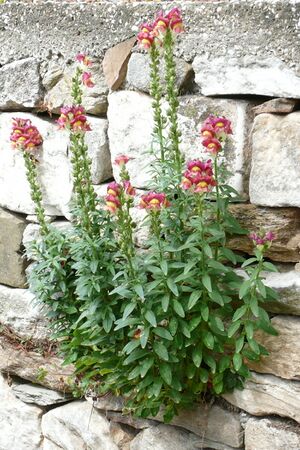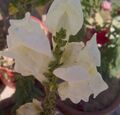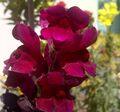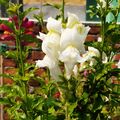أنف العجل (زهرة)
| أنف العجل | |
|---|---|

| |
| Antirrhinum majus | |
| التصنيف العلمي | |
| أصنوفة غير معروفة (أصلحها): | Antirrhinum |
| Type species | |
| Antirrhinum majus | |
| الأقسام | |
| |
أنف العجل Antirrhinum هي جنس من النبات يشيع معرفته بإسم زهرة التنين dragon flowers أو سناب دراغون snapdragons بسبب التشابه الجميل لتلك الزهور بوجه تنين يفتح ويغلق فمه حين يـُقرَص من الجنب. كما يُسمَون أحياناً toadflax[1] أو زهرة الكلب.[2] وتخطئ ويكيبيديا العربية بتسميته زهرة الخطم/الخطمي، التي هي، في الواقع، الاسم العربي للنبات Althaea officinalis، حسب أكبر مرجع عربي في علم النبات، المعجم المصور لأسماء النباتات، المُدخل رقم 245 في ص 4. وهم نوع واطن للمناطق الصخرية في أوروبا والولايات المتحدة وكندا وشمال أفريقيا. أنواع أنف العجل تُستخدم علل نطاق واسع كنباتات زينة في الإطارات وكزهور مقطوعة.[3]
. . . . . . . . . . . . . . . . . . . . . . . . . . . . . . . . . . . . . . . . . . . . . . . . . . . . . . . . . . . . . . . . . . . . . . . . . . . . . . . . . . . . . . . . . . . . . . . . . . . . . . . . . . . . . . . . . . . . . . . . . . . . . . . . . . . . . . . . . . . . . . . . . . . . . . . . . . . . . . . . . . . . . . . .
الوصف
The Antirrhinum is morphologically diverse, particularly the New World group (Saerorhinum).[4] The genus is characterized by personate flowers with an inferior gibbous corolla.
التصنيف
Antirrhinum used to be treated within the family Scrophulariaceae, but studies of DNA sequences have led to its inclusion in a vastly enlarged family Plantaginaceae, within the tribe Antirrhineae.
محيط الجنس
The taxonomy of this genus is complex and not yet fully resolved at present. In particular the exact circumscription of the genus, especially the inclusion of the New World species (Saerorhinum), is contentious.[4] The situation is further complicated by the variety of terms in use for infrageneric ranks, especially of the Old World species, that is Antirrhinum, sensu stricto (e.g. Streptosepalum, Kicksiella, Meonantha).
The USDA Plants Database recognises only two species: A. majus (the garden snapdragon), the only species naturalised in North America, and A. bellidifolium (the lilac snapdragon), now considered to be Anarrhinum bellidifolium (L.) Willd.[5] As of April 2017, The Plant List (Version 1.1) accepts 21 species.[6]
A widely accepted scheme (Thompson 1988) placed 36 species in the genus in three sections. While many botanists accepted this broad circumscription (sensu lato), whose main departure from other classifications was the inclusion of the New World Saerorhinum,[7] others did not, restricting the genus to the Old World. (For a comparison of Thompson with earlier systems, see Oyama and Baum, Table 1.) New species also continue to be discovered (see e.g. Romo et al., 1995).
In 2004 research into the molecular systematics of this group and related species by Oyama and Baum confirmed that the genus sensu lato as described by Thompson is monophyletic, provided that one species (A. cyathiferum) is removed to the separate genus Pseudorontium, and the two species of Mohavea (Mohavea confertiflora and M. breviflora) are included. The species list given here follows these conclusions.[4]
This is the broad circumscription that includes the Old World Misopates and New World Sairocarpus. By contrast the narrow circumscription (sensu stricto) confines the genus to the monophyletic Old World perennial species with a diploid chromosome number of 16, distributed in the Mediterranean basin, approximately 25 species. (Tolety 2011), following the phylogenetic analysis of Vargas et al. (2004) suggesting they are a distinct group. Both Misopates and Sairocarpus are accepted names in The Plant List, and many of the New World species now have Sairocarpus as their accepted name, rather than Antirrhinum. It has been proposed that many of the New World Antirrhinum be now considered under Sairocarpus, in the forthcoming Flora of North America.[8]
تقسيم ما دون الجنس
It is widely agreed that this broad group should be subdivided into three or four subgroups, but the level at which this should be done, and exactly which species should be grouped together, remain unclear. Some authors continue to follow Thompson in using a large genus Antirrhinum, which is then divided into several sections; others treat Thompson's genus as a tribe or subtribe, and divide it into several genera. For a comparison of earlier schemes see Mateu-Andrés and de Paco, Table 1 (2005)[9]
If the broad circumscription is accepted, its three sections as described by Thompson are as follows (two Old World, one New):
- Section Antirrhinum: 19 Old World species of relatively large flowered perennial plants, including the type species Antirrhinum majus, mostly native to the western Mediterranean region with a focus on the Iberian Peninsula. Chromosomes n=8. (3 subsections: Majora, Sicula, Hispanica)
- Section Orontium: two species, also from the Mediterranean. Chromosome number=8. The species in this section, including the section type species Antirrhinum orontium (lesser snapdragon) are often treated in the genus Misopates.
- Section Saerorhinum: 15 small flowered New World species, mostly annual plants and mostly native to California, though species are found from Oregon to Baja California Sur and as far east as Utah. Tetraploid (n=15-16). Like other authors, Thompson placed A. cyathiferum in this section, but Oyama and Baum, following earlier authors, suggest that it should be reclassified in genus Pseudorontium, while Mohavea should be included. Vargas et al., strongly recommending segregation of the New World species suggest that the 14 species originally recognised by Sutton (1988) more properly belong to Sairocarpus (11 species), Howelliella (1 species), and Neogarrhinum (2 species). Other authors would also include Galvezia glabrata, Galvezia juncea, Galvezia rupicola and Galvezia speciosa.[1] None of the names originally allocated to this section are now accepted (see List of Antirrhinum species).
زهرة الخطم
While Antirrhinum majus is the plant that is usually meant by the term of "snapdragon" if used on its own, many other species in the genus, and in the family Scrophulariaceae more widely, have common names that include the word "snapdragon". For example, Antirrhinum molle is known as "dwarf snapdragon" in the UK.[10]
النوع
أصل الاسم
The word "antirrhinum" is derived from the Greek ἀντίρρινον antirrhinon which in turn is derived from ἀντί anti "opposite, counterfeiting", and ῥίς rhis "nose" (GEN ῥινόϛ rhinos); from its resemblance to an animal's mouth.[11]
البيئة
Snapdragons are short-lived perennial plants that survive well in cold seasons but are often replanted each spring and considered annual plants. They do best in full or partial sun, in well-drained soil since their roots are susceptible to rotting (although they do require regular watering[12]). They are classified commercially as a range of heights: midget or dwarf (15–20 cm or 6–8 in), medium (40–75 cm or 15–30 in) and tall (75–120 cm or 30–48 in). Removing the dead flowers, referred to as deadheading, is important to help them to continuously produce beautiful flowers throughout their growing season. They are susceptible to ethylene gas, so removing dead flowers and keeping them away from ripe fruits or vegetables also helps them bloom longer.[13] They grow during their peak seasons of April to June and August to October in the Northern Hemisphere[13] and bloom in a variety of colors such as white, yellow, orange, red, purple, pink,[14] including multicolored patterns.[15]
They are ecologically diverse, particularly the New World species (Saerorhinum).[4]
الزراعة
The snapdragon is an important garden plant, widely cultivated from tropical to temperate zones as a bedding, rockery, herbaceous border or container plant. (Tolety 2011) Cultivars have showy white, crimson, or yellow bilabiate flowers (with two lips). It is also important as a model organism in botanical research, and its genome has been studied in detail.
دراسات وراثية
Antirrhinum is a genus that has been used from the earliest genetic studies of Gregor Mendel and Charles Darwin and was used as a model by Erwin Baur (Tolety 2011). Together with closely related genera, it has become a model organism for the investigation of the genetic basis of plant development, particularly floral development.[4][16] The genus is a typical example of incomplete dominance by the red allele with the anthocyanin pigment. Any cross between red-flowered and white-flowered snapdragons, give an intermediate and heterozygous phenotype with pink flowers, that carries both the dominant and recessive alleles.[17]
Several species of Antirrhinum are self-incompatible, meaning that a plant cannot be fertilised by its own pollen.[18] Self-incompatibility in the genus has been studied since the early 1900s.[18] Self-incompatibility in Antirrhinum species is controlled gametophytically and shares many important features with self-incompatibility systems in Rosaceae and Solanaceae.[19]
. . . . . . . . . . . . . . . . . . . . . . . . . . . . . . . . . . . . . . . . . . . . . . . . . . . . . . . . . . . . . . . . . . . . . . . . . . . . . . . . . . . . . . . . . . . . . . . . . . . . . . . . . . . . . . . . . . . . . . . . . . . . . . . . . . . . . . . . . . . . . . . . . . . . . . . . . . . . . . . . . . . . . . . .
الاستخدامات
In addition to growing the plants for cut flowers, the seeds have been used to extract edible oils, particularly in Russia, while the leaves and flowers have been considered to possess antiphlogistic (anti-inflammatory) properties and have been used in poultices. A green dye has also been extracted from the flowers.[20]
معرض
المراجع
- ^ أ ب Fernández-Mazuecos, Mario; Blanco-Pastor, José Luis; Vargas, Pablo (2013). "A Phylogeny of Toadflaxes (Linaria Mill.) Based on Nuclear Internal Transcribed Spacer Sequences: Systematic and Evolutionary Consequences". International Journal of Plant Sciences. 174 (2): 234–249. doi:10.1086/668790. JSTOR 10.1086/668790. S2CID 85302392.
- ^ "Antirrhinum majus - Dog Flower". www.flowersofindia.net. Retrieved 2022-02-20.
- ^ RHS A-Z encyclopedia of garden plants. United Kingdom: Dorling Kindersley. 2008. p. 1136. ISBN 978-1405332965.
- ^ أ ب ت ث ج Oyama, R. K.; Baum, D. A. (2004). "Phylogenetic relationships of North American Antirrhinum (Veronicaceae)". American Journal of Botany. 91 (6): 918–925. doi:10.3732/ajb.91.6.918. PMID 21653448.
- ^ "Plants Profile for Antirrhinum (snapdragon)". plants.usda.gov. Retrieved May 30, 2020.
- ^ The Plant List: Antirrhinum (retrieved 23 April 2017)
- ^ Thompson, D. M. (1988). Systematics of Antirrhinum (Scrophulariaceae) in the New World. Systematic Botany Monographs 22.
- ^ Barringer, Kerry (2013-05-20). "New combinations in Sairocarpus (Plantaginaceae)" (PDF). Phytoneuron. 2013 (34): 1–3. ISSN 2153-733X. Retrieved 2020-05-30.
- ^ Mateu-Andrés, I.; De Paco, Lorena (Feb 1, 2005). "Allozymic Differentiation of the Antirrhinum majus and A. siculum Species Groups". Annals of Botany. 95 (3): 465–473. doi:10.1093/aob/mci055. PMC 4246802. PMID 15596453 – via academic.oup.com.
- ^ "Antirrhinum molle. dwarf snapdragon". rhs.org.uk. Retrieved 1 September 2017.
- ^ "antirrhinum". Oxford English Dictionary (Online ed.). Oxford University Press. قالب:OEDsub
- ^ "Snapdragon (Antirrhinum majus)". Sunset Magazine. Sep 22, 2004. Retrieved May 30, 2020.
- ^ أ ب "Snapdragon information from Flowers.org.uk". www.flowers.org.uk. Retrieved 2020-04-30.
- ^ Heather, Molly (2023-07-09). "Pink Snapdragon Flowers: Ultimate Guide to Growing & Caring These Beautiful Blooms". organicgardeningeek.com (in الإنجليزية الأمريكية). Retrieved 2023-07-09.
- ^ "Antirrhinum majus - Plant Finder". www.missouribotanicalgarden.org. Retrieved 2020-04-30.
- ^ Wilson, Yvette (2011). "The evolutionary history of Antirrhinum suggests that ancestral phenotype combinations survived repeated hybridizations". The Plant Journal. 66 (6): 1032–1043. doi:10.1111/j.1365-313X.2011.04563.x. PMID 21435047. S2CID 26113532.
- ^ Hartl, Daniel L.; Elizabeth W. Jones (2005). Genetics : analysis of genes and genomes (sixth ed.). Jones & Bartlett publishers. pp. 3.6 Incomplete Dominance and Epistasis. ISBN 978-0-7637-1511-3.
- ^ أ ب Xue, Yongbiao; Rosemary Carpenter; Hugh G. Dickinson; Enrico S. Coen (May 1996). "Origin of allelic diversity in antirrhinum S locus RNases". The Plant Cell. 8 (5): 805–814. doi:10.2307/3870283. JSTOR 3870283. PMC 161139. PMID 8672882.
- ^ Takayama, Seiji; Akira Isogai (2005). "Self-incompatibility in plants". Annual Review of Plant Biology. 56: 467–489. doi:10.1146/annurev.arplant.56.032604.144249. PMID 15862104. S2CID 1196223.
- ^ Tolety 2011
المصادر
- Sutton, D.A. (1988) A Revision of the Tribe Antirrhineae. Oxford: OUP.
- Rothmaler W. 1956. Taxonomische Monographie der Gattung Antirrhinum. Akademie-Verlag, Berlin, Germany.
- Romo, A.; Stubing, G.; Peris, J. B. (1995). "A new species of Antirrhinum (Scrophulariaceae) from North Morocco". Annales Botanici Fennici. 32: 165–168.
- Albach, D. C.; Meudt, H. M.; Oxelman, B. (2005). "Piecing together the "new" Plantaginaceae". American Journal of Botany. 92 (2): 297–315. doi:10.3732/ajb.92.2.297. PMID 21652407.
- Tolety J, Sane A. Antirrhinum , in Kole C (ed.) Wild Crop Relatives: Genomic and Breeding Resources. Plantation and Ornamental Crops. Springer 2011, pp. 1-14
- Doaigey, A. R.; Harkiss, K. J. (December 1991). "Application of epidermal characters to the taxonomy of European species of Antirrhinum (Scrophulariaceae)". Nordic Journal of Botany. 11 (5): 513–524. doi:10.1111/j.1756-1051.1991.tb01258.x.
- Vargas, P.; Rosselló, J. A.; Oyama, R.; Gũemes, J. (2004). "Molecular evidence for naturalness of genera in the tribe Antirrhineae (Scrophulariaceae) and three independent evolutionary lineages from the New World and the Old" (PDF). Plant Systematics and Evolution. 249 (3–4): 151–172. doi:10.1007/s00606-004-0216-1. ISSN 0378-2697. S2CID 20328396.
وصلات خارجية
- CS1 الإنجليزية الأمريكية-language sources (en-us)
- Short description matches Wikidata
- Articles with hatnote templates targeting a nonexistent page
- Automatic taxobox cleanup
- Articles containing Ancient Greek (to 1453)-language text
- Antirrhinum
- Plantaginaceae genera
- Extant Pliocene first appearances
- Plant models
- Anthocyanins
- أصنوفات سماها كارل لينايوس



























